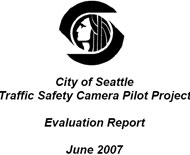8/22/2007
Seattle Red Light Cameras Fail to Reduce AccidentsA draft evaluation report of the Seattle, Washington red light camera program shows no reduction in accidents at camera intersections.

After mailing $1.4 million in tickets to Seattle, Washington motorists, red light cameras have failed to produce any reduction in accidents, according to a draft evaluation report released last month. Instead, the number of collisions at intersections equipped with the devices increased slightly from 4.94 per intersection in the four years prior to camera installation to 5.25 afterward. The evaluation considered accidents that happened between June 22, 2006 and May 31, 2007 at the city's four camera-monitored intersections.
"During the ten months during which police have been authorizing citations, crashes overall have changed little," the report stated.
According to the Insurance Institute for Highway Safety, that is not the end of the story. The insurance group arguest that red light cameras have a "halo" or "spillover" effect where driving habits learned at red light camera intersections carry over to other intersections. Taking this into account, Seattle carefully selected four nearby intersections that would serve as a control. At these locations, injury accidents increased from 6 to 10 compared with a statistically "non-significant" drop from 10 to 7 injury collisions at the camera intersections. The report seized upon this as the only data point suggesting a benefit from camera usage. On the other hand, the same data also suggest the driving habits that spilled over caused an increase in injuries. Such conclusions are difficult because some of the control intersections saw an increase and others a decrease in the number of accidents.
"Examination of the collision data at so-called halo intersections shows no consistent pattern over the ten-month period," the report stated.
Despite the lack of clear, positive results, Seattle police Chief Gil Kerlikowske proposed increasing the number of cameras fourfold to cover 12 to 18 intersections on the day that the draft report circulated. This change would boost revenue to over $5 million a year. The city breaks even when 50 citations are issued in a month. The system collected between 130 and 300 of the $101 tickets per month during the study period.
The Seattle report also noted the unquestioning support the program has received from Washington state media outlets, with any potential criticism of the program ignored or downplayed. The Seattle Times story announcing the city's evaluation report, for example, failed to mention that the overall number of accidents did not decline at camera intersections. Neither of the city's main papers has done any investigative reporting on the subject.
"Local media coverage of the photo enforcement pilot project also has generally been quite positive, as measured by editorial comment and feature stories in both the Seattle Times and the Seattle Post-Intelligencer," the report stated. "The P-I editorial board has been particularly supportive."
The full text of the draft evaluation report is available in a 120K PDF file at the source link below.


